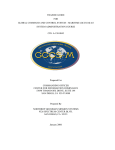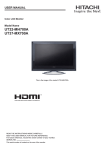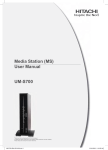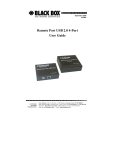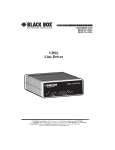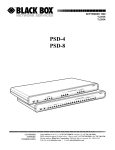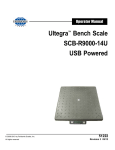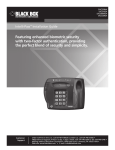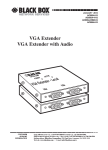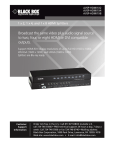Download Digi-Mux HS
Transcript
FEBRUARY 1996 MX700A Digi-Mux HS L LOCAP LOO ux HS igi-M D CH1 RD CH2 RD TD CH3 RD TD CH4 RD TD MAIN DCD RD TEST SYNC LOSS TD TD ER POW CUSTOMER SUPPORT INFORMATION Order toll-free in the U.S.: Call 877-877-BBOX (outside U.S. call 724-746-5500) FREE technical support 24 hours a day, 7 days a week: Call 724-746-5500 or fax 724-746-0746 Mailing address: Black Box Corporation, 1000 Park Drive, Lawrence, PA 15055-1018 Web site: www.blackbox.com • E-mail: [email protected] FCC STATEMENT FEDERAL COMMUNICATIONS COMMISSION AND INDUSTRY CANADA RADIO FREQUENCY INTERFERENCE STATEMENTS This equipment generates, uses, and can radiate radio-frequency energy, and if not installed and used properly, that is, in strict accordance with the manufacturer’s instructions, may cause interference to radio communication. It has been tested and found to comply with the limits for a Class A computing device in accordance with the specifications in Subpart B of Part 15 of FCC rules, which are designed to provide reasonable protection against such interference when the equipment is operated in a commercial environment. Operation of this equipment in a residential area is likely to cause interference, in which case the user at his own expense will be required to take whatever measures may be necessary to correct the interference. Changes or modifications not expressly approved by the party responsible for compliance could void the user’s authority to operate the equipment. This digital apparatus does not exceed the Class A limits for radio noise emission from digital apparatus set out in the Radio Interference Regulation of Industry Canada. Le présent appareil numérique n’émet pas de bruits radioélectriques dépassant les limites applicables aux appareils numériques de la classe A prescrites dans le Règlement sur le brouillage radioélectrique publié par Industrie Canada. 1 DIGI-MUX HS NORMAS OFICIALES MEXICANAS (NOM) ELECTRICAL SAFETY STATEMENT INSTRUCCIONES DE SEGURIDAD 1. Todas las instrucciones de seguridad y operación deberán ser leídas antes de que el aparato eléctrico sea operado. 2. Las instrucciones de seguridad y operación deberán ser guardadas para referencia futura. 3. Todas las advertencias en el aparato eléctrico y en sus instrucciones de operación deben ser respetadas. 4. Todas las instrucciones de operación y uso deben ser seguidas. 5. El aparato eléctrico no deberá ser usado cerca del agua—por ejemplo, cerca de la tina de baño, lavabo, sótano mojado o cerca de una alberca, etc.. 6. El aparato eléctrico debe ser usado únicamente con carritos o pedestales que sean recomendados por el fabricante. 7. El aparato eléctrico debe ser montado a la pared o al techo sólo como sea recomendado por el fabricante. 8. Servicio—El usuario no debe intentar dar servicio al equipo eléctrico más allá a lo descrito en las instrucciones de operación. Todo otro servicio deberá ser referido a personal de servicio calificado. 9. El aparato eléctrico debe ser situado de tal manera que su posición no interfiera su uso. La colocación del aparato eléctrico sobre una cama, sofá, alfombra o superficie similar puede bloquea la ventilación, no se debe colocar en libreros o gabinetes que impidan el flujo de aire por los orificios de ventilación. 10. El equipo eléctrico deber ser situado fuera del alcance de fuentes de calor como radiadores, registros de calor, estufas u otros aparatos (incluyendo amplificadores) que producen calor. 11. El aparato eléctrico deberá ser connectado a una fuente de poder sólo del tipo descrito en el instructivo de operación, o como se indique en el aparato. 2 NOM STATEMENT 12. Precaución debe ser tomada de tal manera que la tierra fisica y la polarización del equipo no sea eliminada. 13. Los cables de la fuente de poder deben ser guiados de tal manera que no sean pisados ni pellizcados por objetos colocados sobre o contra ellos, poniendo particular atención a los contactos y receptáculos donde salen del aparato. 14. El equipo eléctrico debe ser limpiado únicamente de acuerdo a las recomendaciones del fabricante. 15. En caso de existir, una antena externa deberá ser localizada lejos de las lineas de energia. 16. El cable de corriente deberá ser desconectado del cuando el equipo no sea usado por un largo periodo de tiempo. 17. Cuidado debe ser tomado de tal manera que objectos liquidos no sean derramados sobre la cubierta u orificios de ventilación. 18. Servicio por personal calificado deberá ser provisto cuando: A: El cable de poder o el contacto ha sido dañado; u B: Objectos han caído o líquido ha sido derramado dentro del aparato; o C: El aparato ha sido expuesto a la lluvia; o D: El aparato parece no operar normalmente o muestra un cambio en su desempeño; o E: El aparato ha sido tirado o su cubierta ha sido dañada. 3 DIGI-MUX HS TRADEMARKS USED IN THIS MANUAL Any trademarks mentioned in this manual are acknowledged to be the property of the trademark owners. 4 CONTENTS Contents Chapter Page 1. Specifications ................................................................................................6 2. Introduction..................................................................................................7 2.1 General Description .............................................................................7 2.2 Functional Description and Applications ...........................................7 2.2.1 Multiplexing ...............................................................................7 2.2.2 Synchronization..........................................................................7 2.2.3 Timing.........................................................................................8 2.2.4 Diagnostics..................................................................................9 2.2.5 DCE/DTE Selection...................................................................9 3. Installation ....................................................................................................10 3.1 General..................................................................................................10 3.2 Preparing the Site.................................................................................10 3.3 Mechanical Assembly............................................................................10 3.4 Electrical Installation............................................................................10 3.4.1 AC Power Cord ...........................................................................10 3.4.2 Rear-Panel Connectors ..............................................................10 3.4.3 Strap Selection............................................................................10 3.4.4 Changing Internal Jumpers and Switches ................................11 4. Operation......................................................................................................16 4.1 General..................................................................................................16 4.2 Control ..................................................................................................17 4.3 Indicators ..............................................................................................17 4.4 Operating Procedure ...........................................................................19 4.4.1 Power On ....................................................................................19 4.4.2 Self-Test.......................................................................................19 4.4.3 Operation ...................................................................................19 4.4.4 Power Off ....................................................................................19 4.5 Reconfiguring .......................................................................................19 5. Testing...........................................................................................................20 5 DIGI-MUX HS 1. Specifications Multiplexor Technique—Time-division, interleaved Protocol—Synchronous Speed—Link: Up to 2.048 Mbps (with no bit-timing on Channel 4, selectable rates up to 2.048 Mbps); Channel: A 25% split per channel; a 50/25/25 split between channels 1, 2, and 4; a 50/50 split between channels 1 and 4; a 75/25 split between channels 1 and 4 Interface—V.35 Connectors—(5) V.35 34-pin female Indicators—Channels: Transmit (TD), Receive (RD); Link: Transmit (TD), Receive (RD), Data Carrier Detect, Synchronization Loss, TEST Configuration—Link: DTE externally clocked; Link: Channels 1, 2, and 3: DCE or DTE; Channel 4: DCE only Diagnostics—Local loop Temperature—32 to 122°F (0 to 50°C) Humidity—Up to 90%, non-condensing Power—115/230 VAC, 42 to 63 Hz, 10 watts Size—1.7"H x 17"W x 8.2"D (4.3 x 43.2 x 20.8 cm) Weight—4.4 lb. (2 kg) 6 CHAPTER 2: Introduction 2. Introduction 2.1 General Description The Digi-Mux HS is a high-speed, bit-interleaved time division multiplexor, enabling up to four channels to be multiplexed onto the trunk line of a Digital Data Service or modem. It can multiplex two, three or four channels onto one link without overhead. For example, four data sources (such as computers, controllers or multiplexors) operating at a data rate of 64 kbps can share a single modem or DDS link at a data rate of 256 kbps. The DigiMux HS provides full-duplex synchronous operation at selected data rates up to 2048 kbps. 2.2 Functional Description and Applications 2.2.1 MULTIPLEXING The Digi-Mux HS selects one data bit from each active channel and serially transmits the combined data stream over the high speed link. At the receive end, it reverses the procedure, allocating each data bit to its respective channel. 2.2.2 SYNCHRONIZATION The Digi-Mux HS uses one bit in every 2048 bits on the main link to synchronize the data, while it takes bit-time from channel 4 bandwidth. Though this does not result in loss of data, it does prevent connection of a tail-end circuit or DTE equipment that cannot tolerate clock-phase discontinuity to channel 4 (e.g. other TDM multiplexors). Synchronization occurs in 3 stages. Stage 1 The Digi-Mux HS sends a synchronization bit every 4096 bits and waits to receive a similar bit from the remote Digi-Mux HS (within every 4096 bits). After receiving a synchronization bit it advances to the next step. Stage 2 The Digi-Mux HS sends a synchronization bit every 2048 bits and waits to receive a similar bit from the remote Digi-Mux HS before advancing to step 3. NOTE As long as the Digi-Mux HS receives a synchronization bit every 4096 bits, it remains in stage 2. 7 DIGI-MUX HS Stage 3 Full synchronization state. The Digi-Mux HS transmits and receives a synchronization bit every 2048 bits. If it doesn’t receive a synchronization bit at this value, the unit is out of synchronization, and it stops transmitting to the remote Digi-Mux HS (over a long period of time), causing the remote to exit its synchronization state. Both Digi-Mux HSs then revert to stage 1. The synchronization bit in the main channel is transmitted and received in the timeslot of channel 4. To stop the data stream during this time period, the Digi-Mux HS does not send clocks on channel 4. 2.2.3 TIMING The Digi-Mux HS link rate can be up to 2048 kbps and is externally clocked from the modem or the Digital Data Service line. Channel rate is determined as a percentage of the link rate. The Digi-Mux HS supports four modes: 1. Each channel is allocated 25% of the link rate. 2. Channel 1 is allocated 50%, and channels 2 and 4 are each allocated 25% of the link rate. 3. Channel 1 and channel 4 are each allocated 50% of the link rate. 4. Channel 1 is allocated 75% of the link rate, and channel 4 is allocated 25% of the link rate. The clocks to the sub-channels are a division of the main channel clocks, with the division determined according to the mode of operation. The clocks of sub-channel 4 are not the regular clocks, because the synchronization bit produces one missing clock during transmit or receive periods of the bit. For sub-channel 4 clocks there are 2 options, for equipment sensitive to discontinuity in the clock phase (missing clock in the regular clock cycle). Option 1—Without smoothing: The clocks are the nominal clocks, while every 2048 clocks a missing clock occurs. Option 2—With smoothing: The clocks will be set with 50% duty cycle and will not be the nominal clocks. The missing clock period is evenly spread over the other clocks. 8 CHAPTER 2: Introduction 2.2.4 DIAGNOSTICS To activate the Digi-Mux HS’s local main loop, press the front-panel push button. The Digi-Mux HS provides continuous LED monitoring of transmit and receive data for each channel and link, as well as receive Data Carrier Detect and Synchronization loss of the link. 2.2.5 DCE/DTE SELECTION With jumpers, you can set Channels 1, 2 and 3 independently to operate as DCE or DTE, so you can directly connect tail-end circuits to to the Digi-Mux HS without a cross cable. Whenever a channel is set as DTE, an elastic buffer is automatically activated. Time Division Multiplexor Time Division Multiplexor Digi-Mux HS Up to 2.048 bps CSU/DSU Digi-Mux HS V.35 CSU/DSU V.35 Figure 2-1. Remote Units Linked to Central Communication Controller. 9 DIGI-MUX HS 3. Installation 3.1 General This chapter provides information on the mechanical and electrical installation of the Digi-Mux HS. To ensure normal operation after installation, refer to Chapter 4 for operating information and system checkout. 3.2 Preparing the Site The Digi-Mux HS should be installed within 5 feet (1.5 m) of a grounded, easily accessible AC outlet. The outlet should be capable of furnishing 115 VAC or 220 VAC (depending on the power voltage available in your area). Allow at least 36 in (90 cm) of frontal clearance for operating and maintenance accessibility. Ensure that there is at least 4 in (10 cm) clearance at the rear of the unit for signal lines and interface cables. 3.3 Mechanical Assembly The Digi-Mux HS is designed to be placed on a tabletop or bench, and is delivered completely assembled. You cannot bolt the Digi-Mux HS to the tabletop. 3.4 Electrical Installation 3.4.1 AC POWER CORD AC power is supplied to the Digi-Mux HS through a standard 5-foot (1.5-m) detachable power cord terminated by a standard 3-prong plug. The power inlet on the rear panel incorporates an integral fuse. 3.4.2 REAR-PANEL CONNECTORS The main and sub-channels consist of five 34-pin V.35 interface connectors. Table 3-1 provides detailed information on these interface connectors. 3.4.3 STRAP SELECTION After you complete and check the electrical installation, determine the configuration of the Digi-Mux HS in the data system, and position the straps as required. The strap locations noted on the PCB Layout Diagram (Figure 3-1) correspond to the numbers listed under “Strap Identity” in Table 3-2. 10 CHAPTER 3: Installation CH1 DCE DTE 4 CH2 DCE CH3 DTE DCE 5 DTE 6 CHSIS. GND DIS 3 CON 2 1 1 2 3 4 56 01 SW2 MAIN BAUD RATE SW2-4 OFF 0- 2048 1- 1024 23 2- 512 3- 256 4- 129 5- 64 4 CHANNEL SPLIT (%) SW2 CHANNEL 1 2 1 2 3 4 ON ON 25 25 25 25 ON OFF 50 25 25 OFF ON 50 50 OFF OFF 75 25 789 CH4 SMOOTHING SW2-3 ON - YES OFF - NO ON 0- 1729 1- 896 2- 448 3- 224 4- 112 5- 56 Figure 3-1. PCB Layout. 3.4.4 CHANGING INTERNAL JUMPERS AND SWITCHES 1. Disconnect the power cable. 2. Loosen the rear screw holding the top cover in place. 3. Remove the top cover. 4. Adjust the jumpers as required. 5. Replace the top cover and tighten the retaining screw. 11 DIGI-MUX HS Table 3-1. Interface Signal List (female connector). Signal Function Pin Circuit Protective Ground A Frame 101 Chassis ground. May be isolated from signal ground (refer to Table 3-2). Signal B Signal 102 Common signal and DC power-supply ground. Transmitted Data P S TD (A) TD (B) 103 103 Serial digital data from DTE. The data transition must occur on the rising edge of the transmit clock. Received Data R T RD (A) 104 RD (B) 104 Serial digital data to DTE. The data transition must occur on the rising edge of the receive clock. Request to Send C RTS 105 A positive level to the Digi-Mux HS when data transmission is desired. Clear to Send D CTS 106 A positive level from the Digi-Mux HS after receiving RTS. Data Set Ready E DSR 107 A positive level from the Digi-Mux HS when power is on. Data Terminal Ready H DTR 108 Not used. Carrier Detect F DCD 109 A positive level from the Digi-Mux HS. 12 Description CHAPTER 3: Installation Table 3-1 (continued). Interface Signal List (female connector). Signal Function Pin Circuit Description External Transmit Clock U SCTE (A) 113 W SCTE (B) 113 A serial data rate clock input from the data source. Positive clock transition must correspond to data transition. Transmit Clock Y SCT (A) a SCT (B) 114 114 A transmit data rate clock output for use by external data sink. Positive clock transition corresponds to data transition. Receive Clock V SCR (A) X SCR (B) 115 115 A receive data rate clock output for use by external data sink. Positive clock transition corresponds to data transition. 13 DIGI-MUX HS Table 3-2. Digi-Mux HS Strap Selection. Strap Identity Function Possible Settings Factory Setting No. 1 Selects the main Option 1 Main Channel channel data rate (SW2-4=OFF) (SW2-4=ON) Data Rate for channel 4 (kbps) smoothing clocks No. 2 Selects main 0 2048 Option 2 1792 1 1024 896 2 512 448 3 256 224 4 128 112 5 64 56 256 kbps Switch Sub-channel Channel Split(%) split between the 1 1 2 3 4 SW2-1, SW2-2 2 sub-channels On On 25 25 25 25 (measured as On Off 50 25 - 25 a percentage) Off On 50 - - 50 Off Off 75 - - 25 Smoothing Selects sub- On: Smoothing clock 50% duty cycle SW2-3 channel 4’s Off: Without smoothing clock 25 25 25 25 Off clock Main Channel Selects main Off: Option 1 (multiple of 64 bps) Data Rate channel data On: Option 2 (multiple of 56 bps) Off Option SW2-4 rate option CON (for No. 1 above) No. 3 CON setting CON GND connects Signal DIS Ground to Chassis Ground; DIS setting isolates them 14 CHAPTER 3: Installation Table 3-2 (continued). Digi-Mux HS Strap Selection. Strap Identity Function Possible Settings No. 4 Selects equipment DTE for DTE equipment DTE/DCE connected to Factory Setting DCE DCE for DCE equipment sub-channel 1 No. 5 Selects equipment DTE for DTE equipment DTE/DCE connected to DCE DCE for DCE equipment sub-channel 2 No. 6 Selects equipment DTE for DTE equipment DTE/DCE connected to DCE DCE for DCE equipment sub-channel 3 15 DIGI-MUX HS 4. Operation 4.1 General This chapter describes the functions of the controls and indicators, and provides operating instructions and strapping information. You must complete and check the installation as described in Chapter 3 before you operate the Digi-Mux HS. POWER CH 1 TD RD CH 2 TD RD CH 3 TD RD CH 4 TD RD TD MAIN RD DCD SYNC LOSS Figure 4-1. Digi-Mux HS Front Panel. 16 LOCAL LOOP TEST CHAPTER 4: Operation 4.2 Control The Local Loop button located on the front panel performs a loop on the main channel towards the sub-channels. When activated, it loops the transmit main channel data and clock to its receive data and clock. 4.3 Indicators All LED indicators are located on the front panel and described in Table 4-1. The numbers listed under “Item” in Table 4-1 correspond to the identification numbers in Figure 4-1. 17 DIGI-MUX HS Table 4-1. Indicators. Item Indicator LED Color Function 1 POWER Green ON when power is on. 2 CH-1 thru CH-4: TD Yellow ON when steady space is transmitted in sub-channel. Flickers when data is transmitted. 3 CH-1 thru CH-4: RD Yellow ON when steady space is received in sub-channel. Flickers when data is received. 4 MAIN: TD Yellow ON when steady space is transmitted in main channel. Flickers when data is transmitted. 5 MAIN: RD Yellow ON when steady space is received in main channel. Flickers when data is received. 6 MAIN: DCD Yellow ON when a DCD signal is received from the main channel modem. 7 SYNC LOSS Red ON when Digi-Mux HS does not receive a synchronization bit from the remote Digi-Mux HS. 8 TEST Red ON when Digi-Mux HS is in loopback. 18 CHAPTER 4: Operation 4.4 Operating Procedure 4.4.1 POWER ON Apply AC power by connecting the AC power cord to an acceptable AC source, and place the power button on the rear panel in the ON position. The power LED should light up, indicating that the Digi-Mux HS is on. If the local and remote Digi-Mux HS units are connected to modems and all these units are operating and passing data, the following indicator conditions should exist: • POWER: ON • All sub-channels, TD: Flashing or OFF • All sub-channels, RD: Flashing or OFF • Main channel, TD: Flashing • Main channel, RD: Flashing • Main channel, DCD: ON • SYNC LOSS: OFF • TEST: OFF 4.4.2 SELF-TEST To verify that the Digi-Mux HS is operating correctly, use the local loopback test as described in Chapter 5. 4.4.3 OPERATION The Digi-Mux HS operates entirely unattended, except for occasional monitoring of the front panel. 4.4.4 POWER OFF To power off the Digi-Mux HS, simply switch the power button on the rear panel of the Digi-Mux HS to the OFF position. 4.5 Reconfiguring If you must reconfigure the Digi-Mux HS for a different type of operation, you must change the jumpers to correspond to the new operating mode. See Section 3.4.4. 19 DIGI-MUX HS 5. Testing This chapter explains how to use the loopback test. The test switch and front panel indicators built into the Digi-Mux HS allow rapid checking of the Digi-Mux HS. Use the test procedure provided in this chapter to verify normal operation and to isolate faulty equipment in the event of failure. Before testing the operation of data system equipment circuits, make sure that all units are turned on and configured correctly. The test checks the performance of the local multiplexor, the local equipment attached to the multiplexor, and the cables between them. It is performed separately at the local and the remote sites. PROCEDURES 1. Press the LOCAL LOOP button on the front panel. The TEST indicator should turn on. The Digi-Mux HS’s transmit output is now connected to its own receive (Figure 5-1). 2. Verify that the equipment attached to the Digi-Mux HS is operating properly and can be used for test. If a fault is indicated, call a technician or replace the unit. 3. Execute the test using one of the methods described below: a. Use the equipment and check the echoed stream. b. Use an external Bit Error Rate Tester (BERT) unit. 4. Perform step 3 above at both ends. If BERT test equipment indicates no fault, but the regular equipment does indicate a fault, follow the manufacturer’s test procedures for the equipment and verify that the cable connecting the Digi-Mux HS and the equipment is properly connected and in good condition. After completing the test (or when the fault has been corrected), press the LOCAL LOOP button again. The TEST LED should be OFF. 20 CHAPTER 5: Testing 1 Modem 2 TD TC RD RC Main Channel Local Loopback DTE/DCE DTE/DCE 3 DTE/DCE 4 DCE Digi-Mux HS Figure 5-1. Digi-Mux HS in Local Loop. 21 © Copyright 1996. Black Box Corporation. All rights reserved. 1000 Park Drive • Lawrence, PA 15055-1018 • 724-746-5500 • Fax 724-746-0746
























